Seasonic Snow Silent 750W Power Supply Review
Recently, Seasonic introduced a new 750W Snow Silent unit, featuring Platinum-rated efficiency, fully modular cabling and semi-passive operation.
Why you can trust Tom's Hardware
Transient Response Tests
Advanced Transient Response Tests
For details on our transient response testing, please click here.
In these tests, we monitored the response of the PSU in two different scenarios. First, a transient load (10A at +12V, 5A at 5V, 5A at 3.3V and 0.5A at 5VSB) was applied to the PSU for 200 milliseconds while the PSU was working at 20 percent load. In the second scenario, the PSU was hit by the same transient load while operating at 50 percent load. In both tests, we used our oscilloscope to measure the voltage drops caused by the transient load. The voltages should have remained within the ATX specification's regulation limits.
These tests are crucial because they simulate the transient loads that a PSU is likely to handle (like booting a RAID array or an instant 100 percent CPU/GPU load). We call these tests "advanced transient response tests," and they are designed to be very tough to master, especially for a PSU with a capacity of less than 500W.
Advanced Transient Response at 20 Percent
| Voltage | Before | After | Change | Pass/Fail |
|---|---|---|---|---|
| 12 V | 12.133V | 12.050V | 0.68% | Pass |
| 5 V | 5.031V | 4.966V | 1.29% | Pass |
| 3.3 V | 3.348V | 3.258V | 2.69% | Pass |
| 5VSB | 5.095V | 5.060V | 0.69% | Pass |
Advanced Transient Response at 50 Percent
| Voltage | Before | After | Change | Pass/Fail |
|---|---|---|---|---|
| 12 V | 12.121V | 12.044V | 0.64% | Pass |
| 5 V | 5.027V | 4.963V | 1.27% | Pass |
| 3.3 V | 3.345V | 3.254V | 2.72% | Pass |
| 5VSB | 5.060V | 5.016V | 0.87% | Pass |

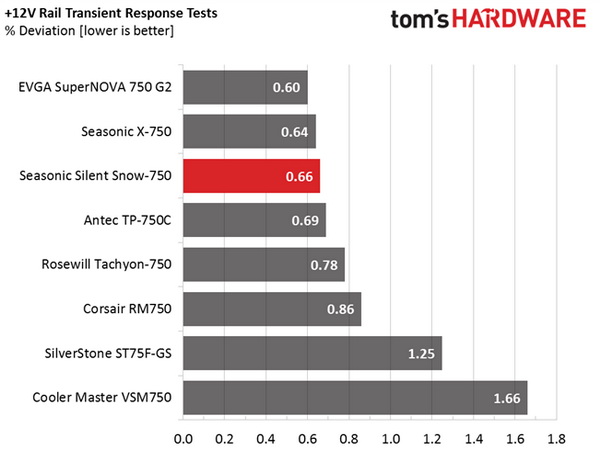
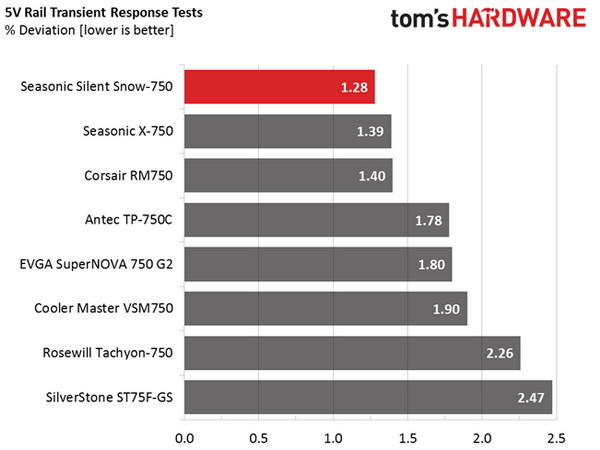

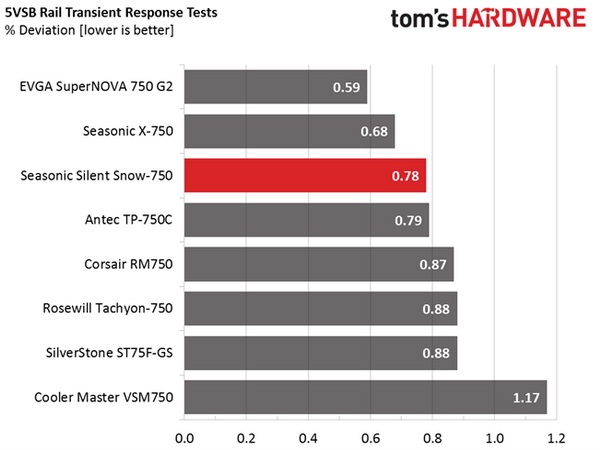
The unit easily handled all of the hurdles we threw at it, showing that, besides excellent load regulation, it also has a great response in transient loads that come close to real-life conditions. A PSU will need to handle transient loads for most of its lifetime, so good performance in these tests is significant.
Here are the oscilloscope screenshots we took during advanced transient response testing:
Transient Response At 20 Percent Load


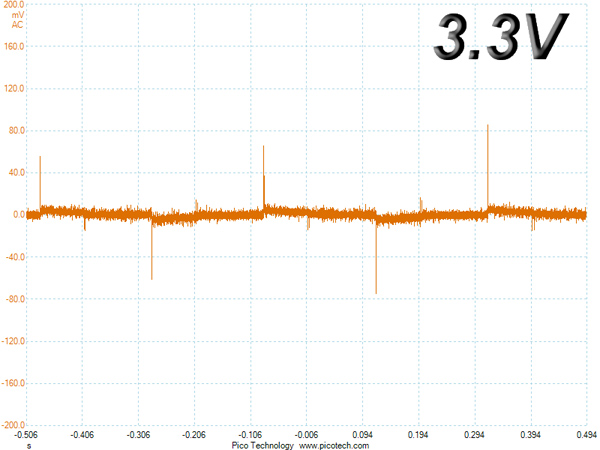
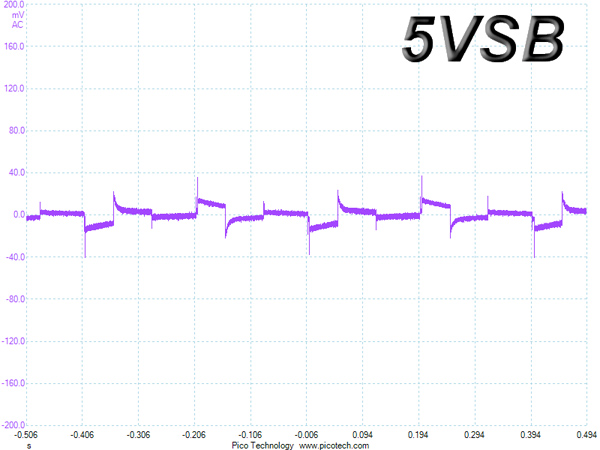
Transient Response At 50 Percent Load
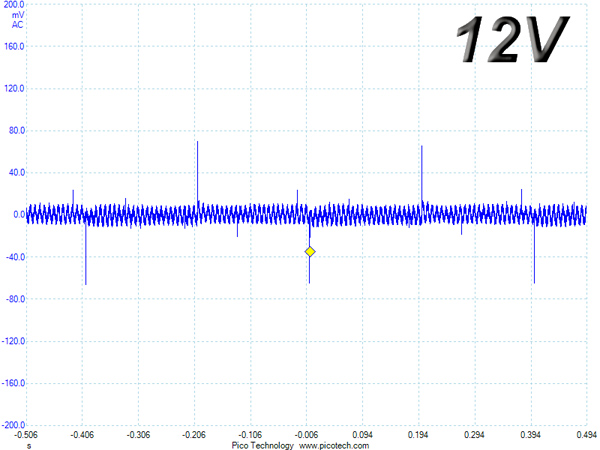


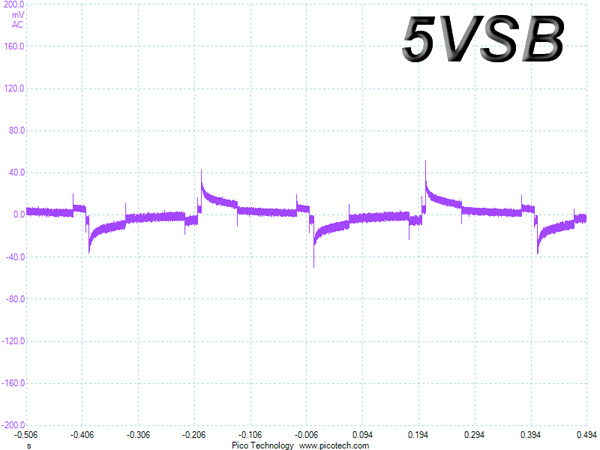
Turn-On Transient Tests
In the next set of tests, we measured the response of the PSU in simpler transient load scenarios during the PSU's power-on phase.
For the first measurement, we turned off the PSU, dialed in the maximum current that the 5VSB could output and switched on the PSU. In the second test, we dialed the maximum load that the +12V could handle and started the PSU while it was in standby mode. In the last test, while the PSU was completely switched off (we cut off the power or switched off the PSU by flipping its on/off switch), we dialed the maximum load that the +12V rail could handle before switching on the PSU from the loader and restoring the power. The ATX specification states that recorded spikes on all rails should not exceed 10 percent of their nominal values (+10 percent for 12V is 13.2V, and 5.5V for 5V).
Get Tom's Hardware's best news and in-depth reviews, straight to your inbox.
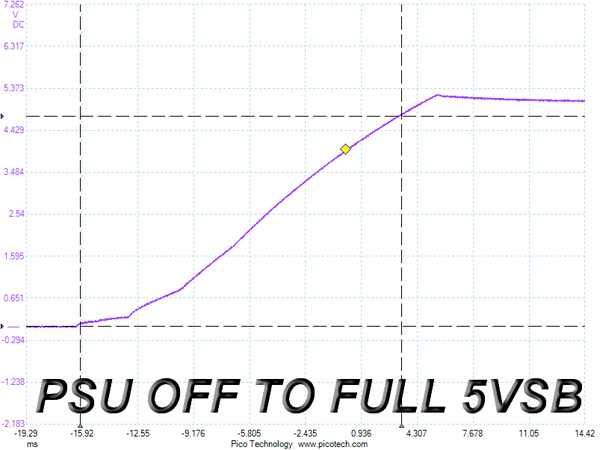


The 5VSB rail took a little longer than usual to reach the nominal voltage, but it still did so in less than 20ms as the ATX spec dictates. In the other two tests, the slopes didn't ramp up smoothly. We noticed some spikes, but they weren't high enough to make us worry. These results were not top-notch, but we can't call them bad or even mediocre.
Current page: Transient Response Tests
Prev Page Cross-Load Tests And Infrared Images Next Page Ripple Measurements
Aris Mpitziopoulos is a contributing editor at Tom's Hardware, covering PSUs.
-
dragget "Unfortunately, the on/off switch for toggling hybrid mode is located on the back side of the PSU, so accessing your system's internals becomes necessary if you want to change fan modes."Reply
Most likely they did it this way to avoid having two switches on the outside face of the PSU. If they had placed both switches there I can see people reaching around the back of their case to change fan modes and accidentally turning off their PC because they flipped the wrong switch. -
Adroid Yea to be honest I prefer the fan/hybrid toggle on the INSIDE of my case anyway. I put my Seasonic Platinum 650W in hybrid mode a long time ago and forgot about it.Reply
I don't see any need to flip the switch on and off, in fact I can't think of a single good reason why I would ever want to touch the thing again. So for me, it would be a con to have the switch on the outside of the case. -
Aris_Mp this switch is much smaller than the on/off one so it is really hard to mix them up. Also the on/off switch is harder to activate. In any case as a reviewer I see this as a con, not a serious though. Some users out there will share my opinion while others won't.Reply -
dragget Replythis switch is much smaller than the on/off one so it is really hard to mix them up.
If you were looking at the back of the PSU, then yes, but I'm assuming the more common situation where the user is reaching around the back of the case where they can't see. In this scenario, one would have to feel around the back with their hand so it's much easier to get it wrong. I almost never use the switch on the back of my PSU, so every two or three months when I DO use it, I have to fumble around in the back to find the switch. For your average user, having two switches back there would just be asking for trouble.
-
MasterDell A lot of companies are putting the hybrid switch on the inside of the PSU. Just like the new units EVGA is putting out. It makes no sense to put the switch on the outside due to confusion with the on/off switchReply -
dstarr3 Reply180 dollars for this? No.
For a rock-solid PSU with a 7-year warranty? This thing would power my next three or four computers. $180 for not having to buy another PSU for a decade is a damn good deal.
Regarding the fan switch, my PSU has a similar feature, and honestly, I imagine most people would set it at installation and never change it. I sure haven't. -
Aris_Mp Indeed a PSU is an investment, something that unfortunately most people cannot see or understand while on the same time they have no problem spending serious money on GPUs and CPUs.Reply
You can keep a good PSU for many system builds while a not reliable, cheap PSU besides breaking down fast can also destroy many of your system components.